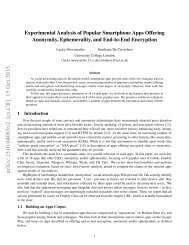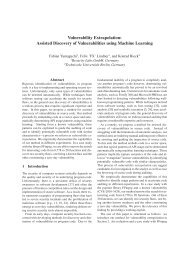Deobfuscating Embedded Malware using Probable-Plaintext Attacks
Deobfuscating Embedded Malware using Probable-Plaintext Attacks
Deobfuscating Embedded Malware using Probable-Plaintext Attacks
Create successful ePaper yourself
Turn your PDF publications into a flip-book with our unique Google optimized e-Paper software.
4 <strong>Deobfuscating</strong> <strong>Embedded</strong> <strong>Malware</strong> <strong>using</strong> <strong>Probable</strong>-<strong>Plaintext</strong> <strong>Attacks</strong><br />
Due to the implementation with only a few instructions, Vigenère-based obfuscation<br />
keeps a small footprint in the code, thereby complicating the task of<br />
extracting reliable signatures for anti-virus scanners. Additionally, this obfuscation<br />
is fast, easily understandable and good enough to seemingly protect malicious<br />
code in the first layer of obfuscation. Despite these advantages Vigenère<br />
ciphers suffer from several well-known weaknesses.<br />
Definition of Vigenère Ciphers. Before presenting attacks against Vigenèrebased<br />
obfuscation, we first need to introduce some notation and define the family<br />
of Vigenère ciphers studied in this work. We consider the original code of a malware<br />
binary as a sequence of n bytes M 1 . . . M n and similarly represent the resulting<br />
obfuscated data by C 1 . . . C n . When referring to cryptographic concepts,<br />
we sometimes denote the original code as plaintext and refer to the obfuscated<br />
data as ciphertext. The Vigenère-based obfuscation is controlled <strong>using</strong> a key<br />
K 1 . . . K l of l bytes, where l usually is much smaller than n. Moreover, we use<br />
ˆK i = K (i mod l) to access the individual bytes of the key.<br />
Using this notation, we can define a family of Vigenère ciphers, where each<br />
byte M i is encrypted with the key byte ˆK i <strong>using</strong> the binary operation ◦ and<br />
decrypted <strong>using</strong> its inverse operation ◦ −1 , as follows:<br />
C i = M i ◦ ˆK i and M i = C i ◦ −1 ˆKi .<br />
This simple definition covers several variants of the Vigenère cipher, as implementations<br />
only differ in the choice of the two operations ◦ and ◦ −1 . For<br />
example, if we define ◦ as addition and ◦ −1 as subtraction, we obtain the classic<br />
form of the Vigenère cipher. Table 1 lists binary operations that are frequently<br />
used for obfuscating malicious code. Note that a subtraction can be expressed<br />
as an addition with a negative element and thus is handled likewise.<br />
Table 1. Operators of Vigenère ciphers used for obfuscation.<br />
Operation Encryption ◦ Decryption ◦ −1<br />
Addition (ADD) (X + Y ) mod 256 (X − Y ) mod 256<br />
Subtraction (SUB) (X − Y ) mod 256 (X + Y ) mod 256<br />
Exclusive-Or (XOR) X ⊕ Y X ⊕ Y<br />
Theoretically, any pair of operations that is inverse to each other can be<br />
used to construct a Vigenère cipher. In practice, most implementations build<br />
on logic and arithmetic functions that induce a commutative group over bytes.<br />
That is, the operation ◦ is commutative and associative as well as there exists an<br />
identity element and inverse elements providing the operation ◦ −1 . These group<br />
properties are crucial for different types of efficient attacks as we will see in<br />
Sections 2.2 and 2.4. Note that ROL and ROR instructions are not commutative<br />
and thus are treated differently in the implementation of our method Kandi<br />
presented in Section 3.









